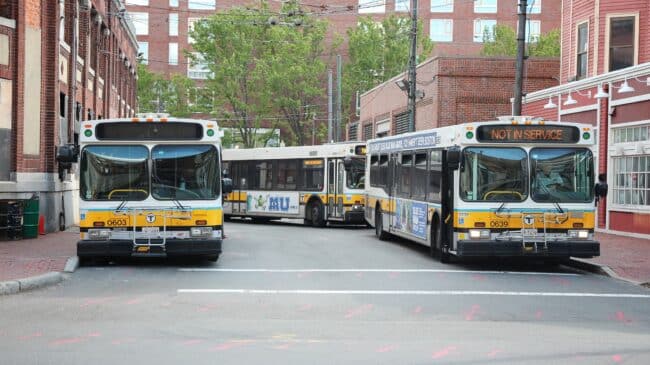Transit ridership continues to decline. While cities and states have received massive stimulus and COVID-19 relief packages from the federal government, local transit agencies are going to have to make do with less money in the future. As a result, interest in bus rapid transit (BRT) as an alternative to light rail appears to be growing. For example, almost 200 people attended the recent American Public Transportation Association’s Bus Rapid Transit Workshop at the group’s Mobility Conference in Columbus, Ohio, which is the highest attendance in the 10 years that I have been attending these conferences and BRT events.
One of the advantages of bus rapid transit is that it is customizable. Some transit corridors need BRT heavy service, where buses operate in a dedicated lane. These are corridors with more than 20 buses per hour with traffic congestion so severe that buses cannot operate efficiently in mixed traffic.
In other corridors, likely about other 90% of BRT surface street corridors, are suited for BRT lite, which operates in mixed traffic. The Transportation Research Board considers transit signal priority (TSP) the most important part of any bus rapid transit system, more important than buses having a dedicated lane. Transit signal priority allows buses to receive a priority green traffic light (five to 10 seconds before other vehicles at the intersection receive a green light) or extend the existing green traffic light by up to 30 seconds. When a BRT vehicle reaches a TSP-enabled intersection, the traffic light is more likely to be green, providing quicker, more reliable bus service for riders. This feature and reliability is crucial to making bus rapid transit a premium transit product for commuters and transit-optional riders.
In terms of infrastructure projects and improvements, transit signal priority is relatively cheap for local governments to install. It costs around $5,000 per intersection if the existing software and controller can be upgraded or $20,000 per intersection if the current software and controller need to be replaced.
Studies have shown that transit signal priority improves bus rapid transit service substantially. On average, bus travel times are reduced by 15% and key intersection delays are reduced by 50% when using transit signal priority. On longer routes, TSP can eliminate around 10-to-15 traffic signal stops. In addition, TSP can help reduce greenhouse emissions from combustion-engine buses because it prevents idling by keeping vehicles moving at a constant speed. Transit signal priority also improves the performance of battery-powered buses since it reduces travel times and allows more consistent charging times.
Most transit agencies have installed transit signal priority on their high-priority routes. But as I learned at the BRT conference, many transit agencies are not using TSP at this time. In general, there are four reasons transit agencies give for foregoing transit signal priority benefits.
First, some transit agencies say they’d only use TSP for a small fraction of the time buses operate. For example, one agency said it only uses TSP if buses are 10 or more minutes late. But if a bus is that far behind schedule, it will be almost impossible to make up the time. It would make more sense to use TSP proactively to prevent buses from becoming late in the first place. Another agency said it only uses TSP during morning and evening peak periods. Yet this very large metro area sees congestion for 10 or more hours a day, seven days a week. Given the way the pandemic has changed travel and work schedules, this is a missed opportunity to improve travel speeds throughout the day.
Turf battles are the second reason that transit agencies don’t use transit signal priority systems. Basically, these battles amount to the transit agency wanting to use the TSP service but the roadway operator, usually a local department of transportation (DOT), does not. Often this conflict comes down to communication about the rules of TSP (when to provide a green signal) and how often TSP can be used per hour. Most local transportation departments want to provide better transit service, so compromises should be possible.
The third reason that agencies don’t use TSP is because the system components are poor. Just like everything else in the intelligent transportation systems world, TSP can be designed well or designed on the cheap. Some agencies have tried to cut corners and install cheap $3,000 intersection controllers or operate TSP on systems with software that is not fully compliant with them. In the case of TSP, agencies should view purchasing the right, quality technology as a wise investment with the potential to improve transit speeds and ridership.
The fourth and final reason that some agencies don’t use TSP sounds like a conspiracy theory and certainly occurs very rarely, but there are a few cases where some local or transit officials may not want bus rapid transit to succeed because they prefer other projects. For example, the mayor’s office may have wanted a light rail system or expansion and thus isn’t supportive of bus rapid transit. Or perhaps the transit agency board wanted BRT heavy service, so they refuse to use transit signal priority in the short-term because it might show BRT lite meets their needs. In some instances, there is dysfunction in the governmental decision-making process.
Clearly, all of these reasons are problematic and should be overcome when transit signal priority would improve bus rapid transit service. Elected officials and transportation leaders need to collaborate to create a plan for using transit signal priority systems because bus rapid transit lite is one of the most cost-effective, high-quality transit options available, but if officials aren’t going to use TSP, they shouldn’t call it BRT.

